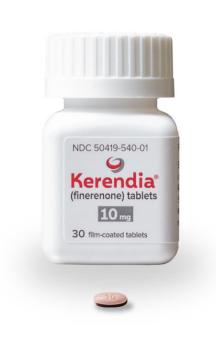Kerendia Side Effects
Generic name: finerenone
Medically reviewed by Drugs.com. Last updated on Aug 3, 2023.
Note: This document contains side effect information about finerenone. Some dosage forms listed on this page may not apply to the brand name Kerendia.
Applies to finerenone: oral tablet.
Serious side effects of Kerendia
Along with its needed effects, finerenone (the active ingredient contained in Kerendia) may cause some unwanted effects. Although not all of these side effects may occur, if they do occur they may need medical attention.
Check with your doctor immediately if any of the following side effects occur while taking finerenone:
More common
- Confusion
- irregular heartbeat
- nausea or vomiting
- nervousness
- numbness or tingling in the hands, feet, or lips
- stomach pain
- trouble breathing
- weakness or heaviness of the legs
Less common
- Blurred vision
- coma
- decreased urine output
- dizziness, faintness, or lightheadedness when getting up suddenly from a lying or sitting position
- fast heartbeat
- headache
- increase thirst
- muscle pain or cramps
- seizures
- sweating
- swelling of the face, ankles, or hands
- unusual tiredness or weakness
For Healthcare Professionals
Applies to finerenone: oral tablet.
General
The most frequently reported adverse reaction was hyperkalemia.[Ref]
Cardiovascular
Common (1% to 10%): Hypotension (includes blood pressure decreased, diastolic blood pressure decreased, diastolic hypotension, hypotension)
Frequency not reported: Systolic blood pressured decreased, diastolic blood pressure decreased[Ref]
In patients treated with this drug, the mean systolic and diastolic blood pressure decreased by 2 to 4 mmHg and 1 to 2 mmHg, respectively, at month 1 and remained stable thereafter. Most hypotension events were mild or moderate and resolved; events associated with hypotension (e.g., dizziness, syncope, fall) were not more frequent in patients treated with this drug compared to placebo.[Ref]
Dermatologic
Common (1% to 10%): Pruritus[Ref]
Hematologic
Common (1% to 10%): Anemia
Uncommon (0.1% to 1%): Hemoglobin decreased
Frequency not reported: Hematocrit decreased[Ref]
Metabolic
Very common (10% or more): Serum potassium increased (up to 21.7%), hyperkalemia (includes blood potassium increased, hyperkalemia; up to 18.3%)
Common (1% to 10%): Hyponatremia (includes blood sodium decreased, hyponatremia)[Ref]
In a study, hyperkalemia events were reported in 18.3% of patients treated with this drug; most hyperkalemia events were mild to moderate in patients treated with this drug. Serious hyperkalemia events were report more often for this drug than placebo; serum potassium levels greater than 5.5 mmol/L and greater than 6 mmol/L were reported in 21.7% and 4.5% of patients treated with this drug and in 9.8% and 1.4% of those treated with placebo, respectively.
An increase from baseline in mean serum potassium in the first month of therapy was about 0.2 mmol/L in patients treated with this drug.[Ref]
Nervous system
Frequency not reported: Dizziness, syncope[Ref]
Other
Frequency not reported: Fall[Ref]
Renal
Common (1% to 10%): Estimated glomerular filtration rate (eGFR) decreased/GFR decreased[Ref]
This drug caused an initial small decrease in eGFR (mean 2 mL/min/1.73 m2); it occurred within the first 4 weeks of therapy and then stabilized. In a study including patients with chronic kidney disease associated with type 2 diabetes, this decrease was reversible after therapy was stopped.[Ref]
Frequently asked questions
More about Kerendia (finerenone)
- Check interactions
- Compare alternatives
- Pricing & coupons
- Reviews (2)
- Drug images
- Dosage information
- During pregnancy
- FDA approval history
- Drug class: aldosterone receptor antagonists
- Breastfeeding
- En español
Patient resources
Professional resources
Related treatment guides
References
1. Product Information. Kerendia (finerenone). Bayer Plc. 2022.
2. Product Information. Kerendia (finerenone). Bayer Pharmaceutical Inc. 2021.
3. Product Information. Kerendia (finerenone). Bayer Australia Ltd. 2021;1.0.
Further information
Always consult your healthcare provider to ensure the information displayed on this page applies to your personal circumstances.
Some side effects may not be reported. You may report them to the FDA.

